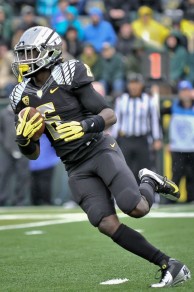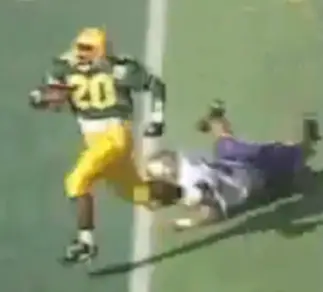Today, the college football landscape requires an exceptional amount of athleticism. Bigger players are now faster and more specialized than they used to be, and size has become a true emphasis in the game.
This is proven by the recent success of SEC teams that play host to physical freaks such as Alabama’s D.J. Fluker, a 6-foot-5, 340-pound run-blocker, or Tennessee’s Daniel McCullers, a monstrous defensive tackle who stands in at 6-8 and 375 pounds. His nickname is “The Smoky Mountain” for good reason.
Major conferences such as the SEC and the Big-10 have boasted about their size for a while, and rightfully so considering the success that all of their large bodies have found over the past couple of decades.

De’Anthony Thomas, who stands in at a mere 5’9″, 180 pounds, shows that small, speedy players can succeed in a college football landscape that has an increasing emphasis on size.
However, this emphasis on size often leads to an antagonistic view of smaller, faster teams, such as those from the PAC-12 or Big-12. The Oregon Ducks, without a doubt, fall into that category.
Sure, the Ducks have had their share of Haloti Ngatas and Arik Armsteads over the years, but the ultimate trend that has dominated Oregon football’s history, especially in the modern era, has been speed, endurance and athleticism over size.
Recently, this dichotomy of size and speed has been perpetuated by a somewhat condescending attitude from the “big boys” towards smaller squads, referring to the spread, up-tempo offensive systems used to compensate for a lack of size as “gimmicky.”
Oregon has felt this disrespect during its recent rise to the national spotlight. LaMichael James, De’Anthony Thomas and Kenjon Barner have each been questioned in terms of their size despite their consistent success on the field.
On the other side of the ball, the same goes for the new Dion Jordan-type edge rusher. This breed of player has plenty of length and athleticism, but is often lacking in terms of bulk.
Nonetheless, looking back throughout the modern era, the Ducks have always found a way to succeed with undersized players.
Back in the late 1970s, defensive tackle Vince Goldsmith marked one of the best examples of this. At 5-10 and 230 pounds, most schools would have considered him too small to let him start on their defensive line. The undersized stud earned all-conference honors multiple times, and all-American honors in 1980 after the Ducks gave him the starting nod during the first game of his career.
In the 1980s, some of Oregon’s greatest play makers were overlooked by other schools due to a lack of size as well.
All-around talents such as Tony Cherry and Lew Barnes, who were both electric on offense and in the return game,
lacked great bulk, but proved to be dominant with the ball in their hands.
Even Bill Musgrave, one of the most celebrated quarterbacks in Oregon football history, barely filled out his 6-2 frame at 190 pounds. The endearing freshman took the field with all the confidence in the world in 1987 and found a way to win football games despite is lanky build.
And no Duck fan could forget about Kenny Wheaton, who stood in at 5-9, but never backed down from a bigger receiver. In fact, it was the cornerback’s quickness, instincts, and desire to win that allowed him to make so many great plays, including his famous Pick-6 against Washington, better known as “The Play that Changed Oregon Football” or just simply “The Pick.”
Again, it is only fair to admit that the Ducks have had a decent number of players with great size throughout the modern era. However, smaller, speedy players with great instincts and technique, like the ones listed above, seem to have won out in terms of sculpting the team’s image and reputation.

Running back Kenjon Barner, who has a relatively slight frame for his position, was passed over by many other schools before landing at Oregon where he thrived for four years.
The college football world sees the Ducks as an undersized team that makes up for it with speed, endurance, and athleticism on both sides of the ball. This view often comes in the form of disrespect from the schools down in the South or in the Midwest that recruit from a hotbed of large prospects year in and year out.
However, Oregon has proven throughout the years that it can succeed without the elite size of the “big boys.” Some of the greatest players in Oregon football history were considered too small by most other schools, and made the most of their chance in Eugene.
This holds true even today.
Many see Alabama as the epitome of size and Oregon as the epitome of speed, hoping to see a match up between the two. It will take a bowl win over an SEC team to truly mark Oregon’s spot as one of the nation’s powerhouses in the minds of college football fans, but the Ducks are more than capable of the accomplishing this feat with their own unique recipe.
Be sure and check out our new Chip Kelly Philly update every Friday!
Related Articles:
Oregon Enters Playoffs Better Off Than Last Year
Will The Coaching Carousel Kill Oregon's CFP Chances?
The Playoff Formula Hasn't Changed
Oregon Aims to Bury Dawgs, Punch Playoff Ticket in Rivalry Clash
Huskies Are the New Beavers, Stay In Your Lane Kiffin, and the Civil Apple Cup War
Oregon Football: The X-Factor Vs. Washington
Joey Holland graduated from the University of Oregon in 2013, majoring in History. He played several sports in high school, though football remains his passion. He has yet to miss a single Oregon Ducks home football game during his time in Eugene. Joey has written previously for Bleacher Report and Football Nation.
Joey welcomes your feedback.

